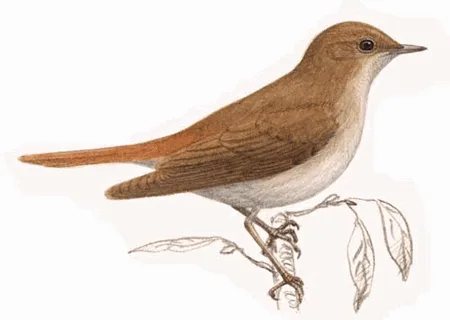
Common Nightingale
[order] PASSERIFORMES | [family] Muscicapidae | [latin] Luscinia megarhynchos | [UK] Common Nightingale | [FR] Rossignol philomele | [DE] Nachtigall | [ES] Ruisenor | [NL] Nachtegaal
Subspecies
| Genus | Species | subspecies | Breeding Range | Breeding Range 2 | Non Breeding Range |
| Tarsiger | megarhynchos | ||||
| Luscinia | megarhynchos | EU | c, w | AF | |
| Luscinia | megarhynchos | africana | |||
| Luscinia | megarhynchos | hafizi | |||
| Luscinia | megarhynchos | megarhynchos |
Physical charateristics
Medium-sized, graceful chat, with alert, rather upright carriage, noticeably uniform plumage, and skulking habits.
Russet-brown above, warmest on tail, dull brown-grey below, with paler throat and vent, pale eye-ring emphasizes gentle expression.
Flight flitting and low. Song rich and fluty.
Sexes similar, no seasonal variation.
Russet-brown above, warmest on tail, dull brown-grey below, with paler throat and vent, pale eye-ring emphasizes gentle expression.
Flight flitting and low. Song rich and fluty.
Sexes similar, no seasonal variation.
| wingspan min.: | 22 | cm | wingspan max.: | 25 | cm |
| size min.: | 15 | cm | size max.: | 16 | cm |
| incubation min.: | 12 | days | incubation max.: | 14 | days |
| fledging min.: | 10 | days | fledging max.: | 14 | days |
| broods: | 1 | eggs min.: | 3 | ||
| eggs max.: | 6 |
Range
Eurasia : Central, West
Habitat
Breeds in west Palearctic in middle and lower-middle latitudes, with some oceanic hias, in mild and warm temperate, Mediterranean, and steppe climatic zones.
Differs from Thrush Nightingale in more southerly, westerly, and generally somewhat warmer breeding range, less restricted to lowlands, valleys, and neighbourhood of water in most regions, and more ready to inhabit drier sandy soils and sunny hillsides.
Differs from Thrush Nightingale in more southerly, westerly, and generally somewhat warmer breeding range, less restricted to lowlands, valleys, and neighbourhood of water in most regions, and more ready to inhabit drier sandy soils and sunny hillsides.
Reproduction
The nest of the nightingale is built by the female and is usually concealed in the brush, near the ground. The female lays 4-5 eggs which are pale green in color. It takes approximately 11-12 days for the eggs to hatch.
Feeding habits
In breeding season, terrestrial invertebrates, especially beetles and ants. Feeds on ground, taking food mostly from litter layer but also from bare ground and from leaves or twigs or while gripping bark.
Move on ground by long hops with also drop on to prey from perch and catch insects in flight.
Move on ground by long hops with also drop on to prey from perch and catch insects in flight.
Conservation
This species has an extremely large range, and hence does not approach the thresholds for Vulnerable under the range size criterion (Extent of Occurrence <20,000 km2 combined with a declining or fluctuating range size, habitat extent/quality, or population size and a small number of locations or severe fragmentation). The population trend appears to be increasing, and hence the species does not approach the thresholds for Vulnerable under the population trend criterion (>30% decline over ten years or three generations). The population size is extremely large, and hence does not approach the thresholds for Vulnerable under the population size criterion (<10,000 mature individuals with a continuing decline estimated to be >10% in ten years or three generations, or with a specified population structure). For these reasons the species is evaluated as Least Concern.
Luscinia megarhynchos is a widespread summer visitor to southern and western
Europe, which constitutes >50% of its global breeding range. Its European breeding
population is very large (>4,200,000 pairs), and was stable between 1970-1990.
Although there were declines in France and Turkey during 1990-2000, these were set
against stable trends or increases in other key populations such as Italy and Croatia,
and the species probably remained stable overall.
Luscinia megarhynchos is a widespread summer visitor to southern and western
Europe, which constitutes >50% of its global breeding range. Its European breeding
population is very large (>4,200,000 pairs), and was stable between 1970-1990.
Although there were declines in France and Turkey during 1990-2000, these were set
against stable trends or increases in other key populations such as Italy and Croatia,
and the species probably remained stable overall.

Migration
Migratory, wintering in Afrotropics. Western populations (nominate megarhynchos, breeding in Europe, western Turkey, and north-west Africa) winter between Sahara and rain forest from West Africa east to Uganda. European breeding birds leave in autumn between end of July and September. Movement through Europe broadly south-west, with birds occurring throughout Mediterranean region though commonest in west. The relative scarcity in much of North Africa and also Middle East in autumn suggests Mediterranean and Sahara normally crossed in one continuous flight. Present in winter quarters from early November to early April. Some present in Afrotropics until early May, but spring passage through Nigeria concentrated in late March and early April with arrivals in North Africa and southern Europe at this time. Unlike autumn, many records in spring along North African coast and on Mediterranean islands and even commonly inland in Algeria and Libya, so passage obviously on broad front.
Distribution map

